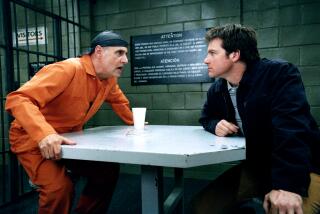Tracing History of ‘Television’ : 8-Part PBS Series Looks at Development of the Medium in the U.S.
- Share via
Trying to chart the history of television in only eight hours is a little like trying to engrave the history of the world on the head of a pin.
How can the thousands of hours of comedy, drama, sports, news, triumphs and tragedies telecast over nearly 60 years be covered in 480 minutes?
Three public television producers--admitted and unabashed TV fans--tackled that task, and the result is “Television,” an eight-part series that begins Monday on PBS (8 p.m. on Channels 28, 58 and 15, 9 p.m. on Channel 50, 10 p.m. on Channel 24).
“Television” was inspired by a 13-hour Granada Television series of the same title that aired to wide acclaim in England three years ago.
“That series was our ground base,” said Michael Winship, writer-producer of the U.S. series with executive producer-director Jack Sameth and producer Susan Kim.
“Working from that material gave us a terrific starting point. But only about 35% of the Granada series was used. The other 65% is new material: interviews that we shot or new footage that we culled.”
“Our original strategy,” Sameth said, “was to update the Granada series, but when we got familiar with it, we found it was really too British. The references and the material would not have been right for an American audience. So Mike (Winship) and I took the big step and said we’re going to make a brand new series.”
Both versions look at television through program types: comedy, drama, live coverage, news and one that encompasses game shows, talk shows and music and variety programs. The idea is not so much to show “best of” highlights, but rather to trace the development of television in these areas. For example, the hour on comedy tracks how Milton Berle’s early vaudeville-like series was followed by bland, family-oriented situation comedies, then gimmick sitcoms with talking horses and cars, the harsh humor of “All in the Family,” the one-parent family shows up to the current brash, contemporary comedians seen on cable television.
In addition, there’s a segment on “The Race for Television” (including rare footage from the 1920s) and a final hour that ponders “The Promise of Television,” covering how the tube has fulfilled its promise and betrayed it. Edwin Newman hosts all eight segments.
Winship said, “In the course of looking at the history, success stories, disasters, trends and problems of the medium, you do see a lot of wonderful moments of American television history.”
The oldest clip is from 1926, a wiggly experimental picture conjured up in Great Britain by John Logie Baird. One of the latest inclusions: Lt. Col. Oliver North. “An Oliver North comes along while you’re working on the project and you make a judgment that there should be some discussion of that in the series,” Winship said.
Said Kim: “The clip selection process was pretty continual, and there were some hard choices. Everyone was suggesting clips they thought should be included, but tracking them down was something else. Just finding a cogent clip from some very popular series was hard. The overall material of a show might be wonderful, but trying to find the right moment that summed it up was often impossible.
“Even once we had the broad strokes of the series laid out, the guide was constantly being revised. There was a lot of discussion-slash-argument that went on right into the final editing. And there were a lot of specific shows that we all felt strongly about that didn’t make it for various reasons.”
Of the three producers, Sameth has been in television the longest, having started with ABC in 1950. There, he was a producer-director for dramas, news programs, coverage of the manned space flights and presidential debates. Now an executive producer at WNET in New York, he produced “The Brain” and has another major PBS series, “The Mind,” coming up this year.
Winship entered broadcasting in 1974 and has worked extensively in news and public affairs for WNET, in addition to being head writer for “Smithsonian World” and creative consultant to the TV division of the National Geographic Society. He has also written a companion book to the “Television” series, published by Random House.
Kim started in cable television in 1980 (CBS Cable and HBO) before moving to public television.
Kim, Winship and Sameth have been associated on several past PBS projects, including “Juke Box Saturday Night,” “A Musical Toast” and “Benny Goodman--Let’s Dance.”
Together, they brought an intergenerational view to the production of “Television.”
“I’ve got two television junkies here,” Sameth said with a wave in the direction of Winship and Kim. “I was working in the business when they were growing up. But their knowledge of the business amazed me. They’re extraordinarily bright and they have a deep interest in television.”
Still, the generation gap was evident on occasion.
Sameth recalled his two younger associates coming up with a “Twilight Zone” excerpt about a man warned not to go up in a spaceship because the aliens who talk of “serving” mankind mean as a meal.
“Well, these two just died over that, and to this day, I don’t know why,” Sameth said. “But I trust them, so it’s in.”
Kim piped up: “Well, Fred Waring was yours, Jack. Fred Waring and the Pennsylvanians singing ‘Some Enchanted Evening’ sort of washed over me. . . .”
Added Winship: “The selection of material was very subjective, and ultimately was a consensus among the three of us. We didn’t want this to be a show where you use a montage to get everything in. We wanted to run a scene for two or three minutes if it merited that.”
Sameth mentioned one comedy clip they found with Groucho Marx, Ethel Barrymore and Tallulah Bankhead.
“You couldn’t cut a second out of that,” he said.
In all, they looked at more than 2,000 hours of television’s past to select material for their production. One day alone, Winship spent nine hours reviewing coverage of Ronald Reagan’s 1981 inauguration.
“Under one minute ended up in the final show,” he said. “The premise was to show television news expanding in such a way that breaking stories could be covered simultaneously--in this case, the inauguration and the release of the U.S. hostages (held in Iran).”
All three producers mentioned repeatedly the cooperation they received from individuals, unions, studios and networks in making material available.
“They opened their vaults. We were very fortunate,” Winship said.
Still, a mound of paper work had to be done to get clearances from everyone involved with the hundreds of clips shown on “Television.”
Could this historical retrospective find its way into home video?
“Our fingers would be cut off if we even tried that,” Kim replied. “It would be too complicated legally to even think about. So many people donated materials for the series that to go off into the video market would be impossible.”
For now, “Television” has the standard PBS release of four domestic plays in three years, Winship said. And what about a “Television II”?
“There’s enough material to do a 26-week series,” Winship said. The question would be funding.
MCI Communications Corp., in its first venture into public television, is the sole corporate funder of “Television,” with a grant of more than $1 million for the production, backed up with an additional $2 million for an extensive advertising and promotion campaign to attract the broadest possible audience. William G. McGowan, chairman of the board of MCI, said the series was an ideal project for his company, since “we’re both in the communications business.”
The series is a production of WNET/New York and KCET Channel 28 in Los Angeles, in association with Granada Television of England.
So what are the conclusions at the end of eight hours?
“We make our points,” Winship said, “but with the understanding that viewers must also arrive at their own conclusions. We didn’t set up a series dealing with the industry to knock it down.
“The notion is more to provoke thinking and discussion about television than to come down with pronouncements on what it is, what it should be and what it isn’t. ‘Television’ is also an entertainment series.
“The bottom line is that even with its faults and problems, this is a business that we love and are proud to be in.”
More to Read
The complete guide to home viewing
Get Screen Gab for everything about the TV shows and streaming movies everyone’s talking about.
You may occasionally receive promotional content from the Los Angeles Times.






